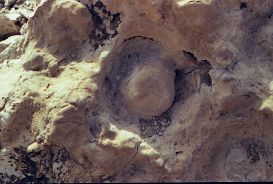From: "A
STEP TOWARDS HUMAN ORIGINS"
The Buya Homo one-million years ago in the Eritrean Danakil Depression (East Africa)
Volume 110, supplement - July 2004. Rivista Italiana di Paleontologia e Stratigrafia.(ISSN: 0335-6883)
Alat's mysterious "donuts"
A3
- Distinctly-recognizable composite key horizons consisting of 2 to
3 Calcareous beds, which are 5 to 20 cm thick, intensely bioturbated
and alternating with thin silts and clays (Fig. 10 a, e, f). These calcareous beds exhibit peculiar ring-like
structures that are preserved as concave circular depressions on the
surface of the bedding plane (Fig. 10 b). These impressions are casts of an oolite-rich sand
that can be massive or faintly laminated, and subordinately contain
Cypria ostracods and fish spines. Their mineral composition
is mainly calcitic or dolomitic with secondary barite and phyllosilicates.
On overturned beds these casts look like "donuts" and this term is
used to designate this basin-wide key horizon. Sometimes donuts overlap
(Fig. 10 c, d). We estimate average density of 50 donuts per 100sq
meters to greater occurrence as in the outcrop of fig 10 f.
To our knowledge they cannot be equated to any ring-like structures
described in the literature and their ambiguous features make it problematic
to relate them either to just biological or physical processes. The
donuts of the Alat Formations will be the subject of a paper in progress.
Preliminary hypothesis on their origin take into account their similarities
with nests dug by some fish species in the mud flats along the margins
of the East Africa rift valley lakes (Fleibel 1987). In the same environment
flamingos build nests as small circular mounds.
Donuts may be also compared to casts of corms and bulbs of plants
living in the marshes or swamps. Corn rootlets may be matched with
some finger-like casts that are found associated with the donuts.
Affinities with ring structures produced by impact or gas seepages
(Aiello et al. 2001) are less convincing.
The picture in the middle shows a donut with a protruding "cork", a positive print; right, a negative print. Click to enlarge.
[1] All the original pictures of http://www.dankalia.com/ are in the public domain and can be freely used.



